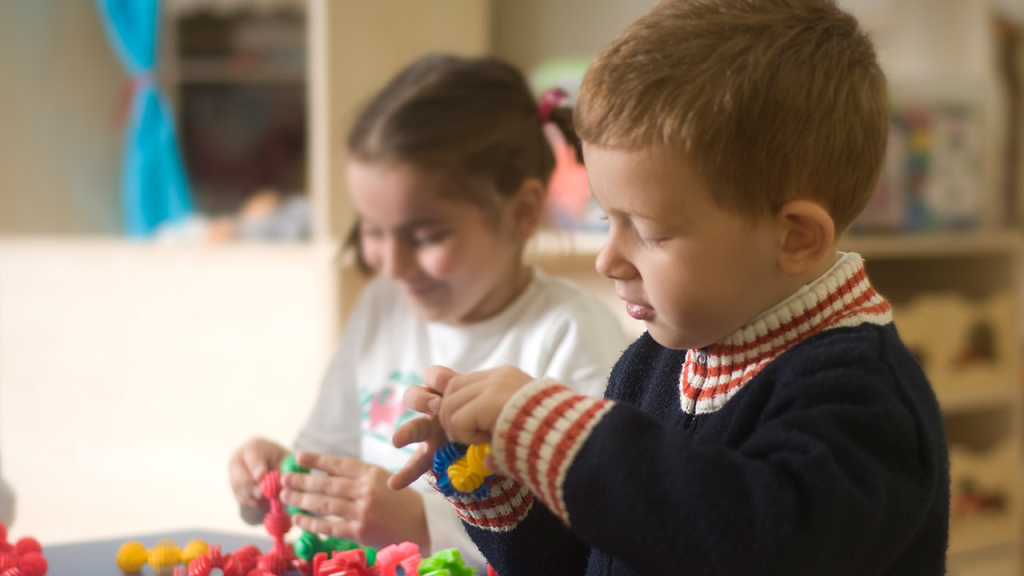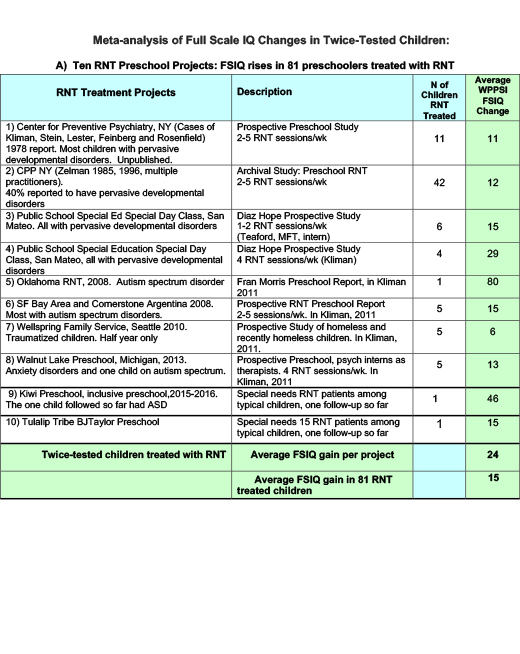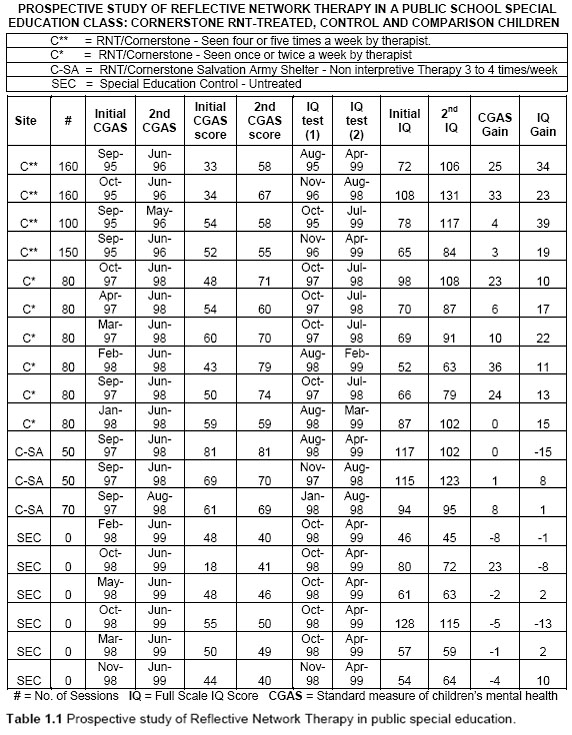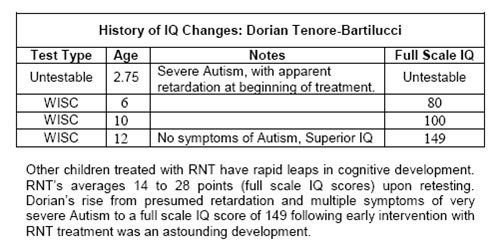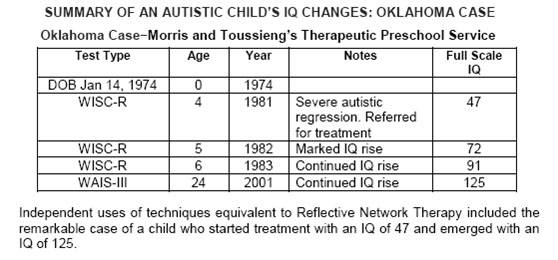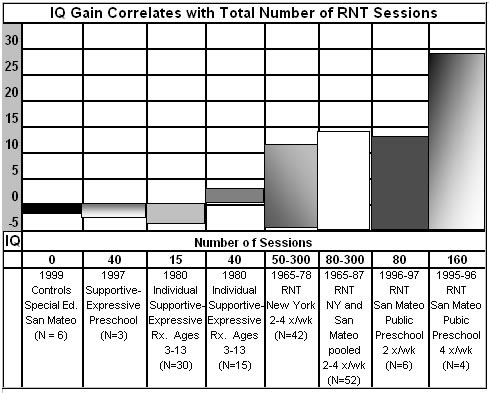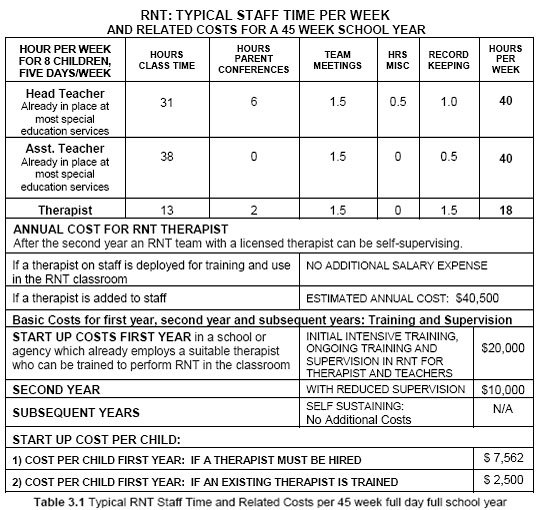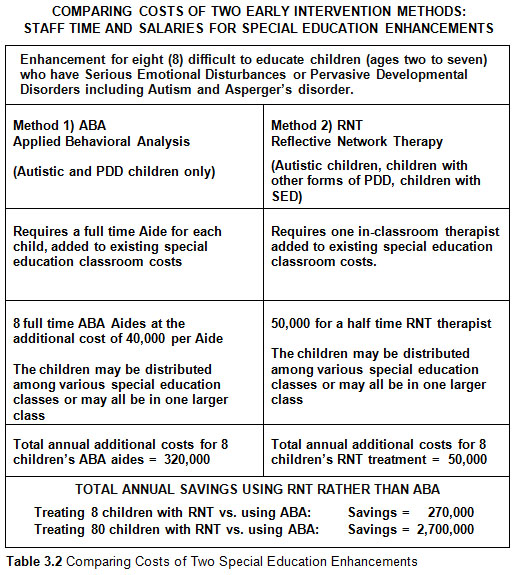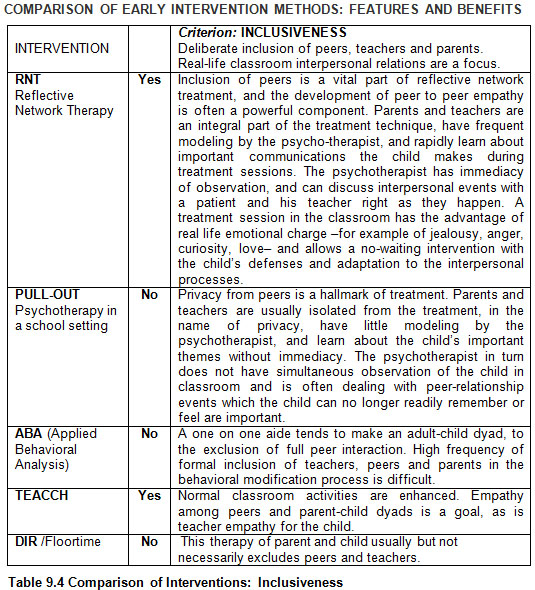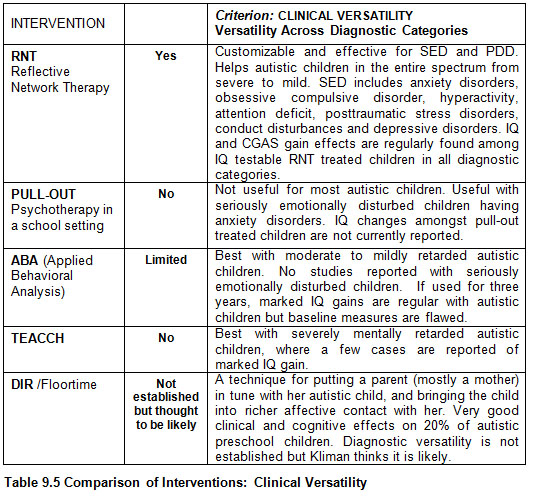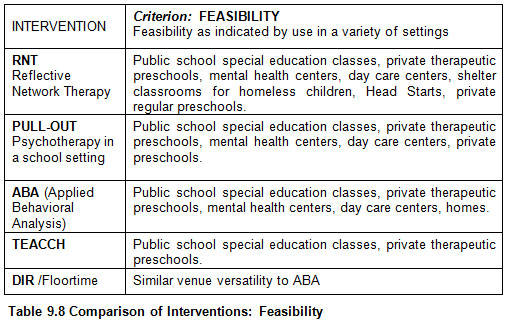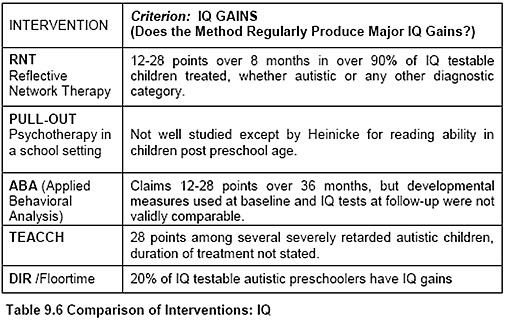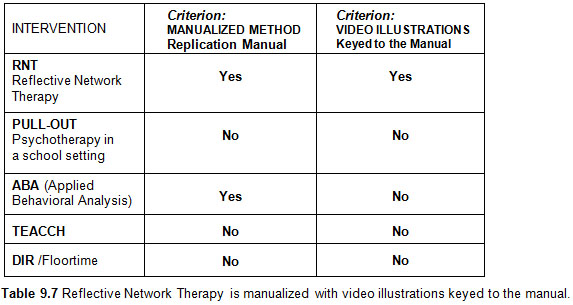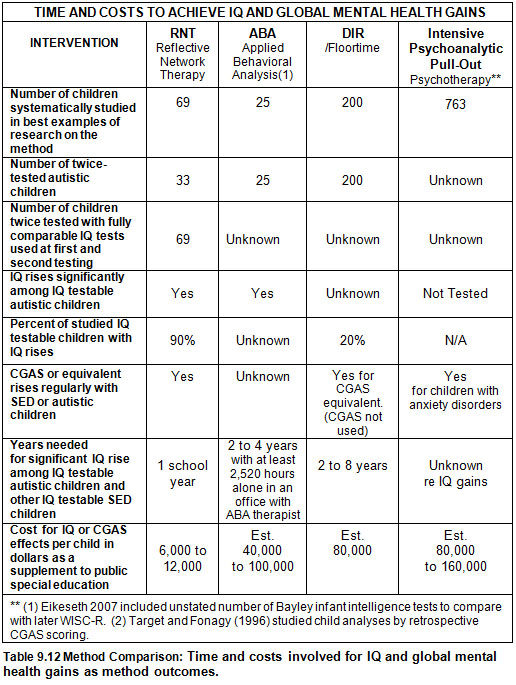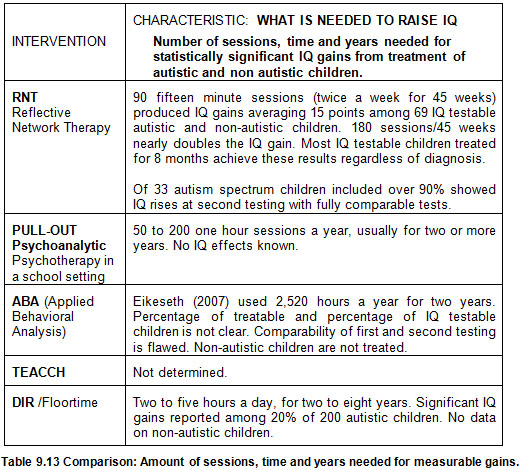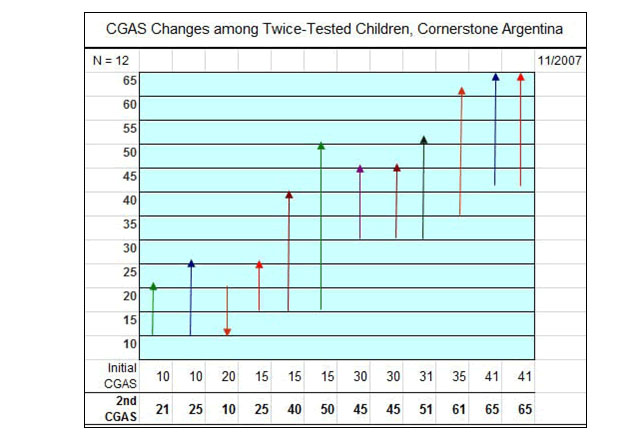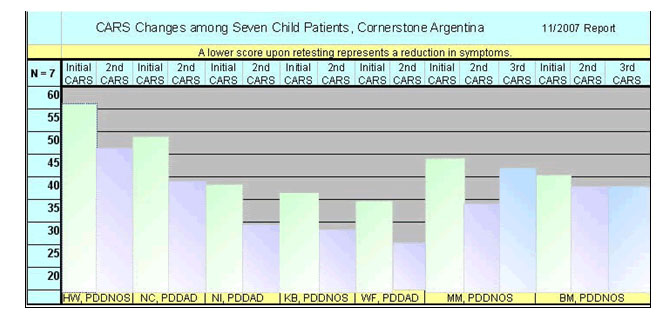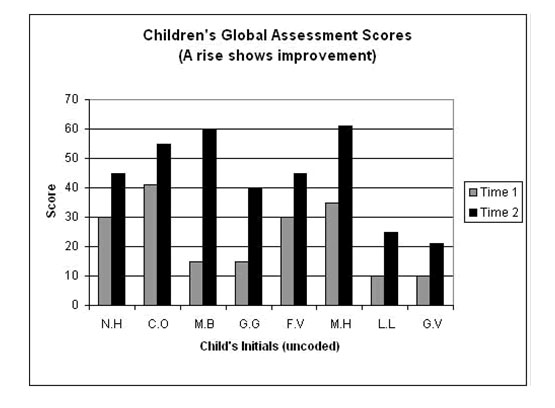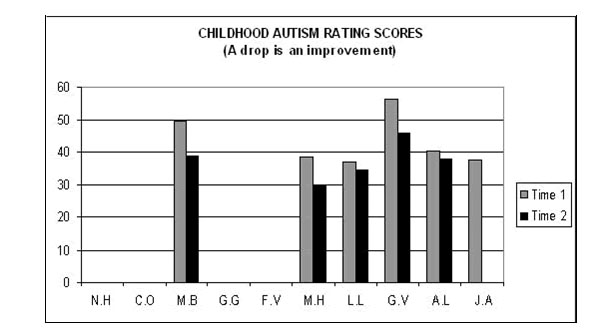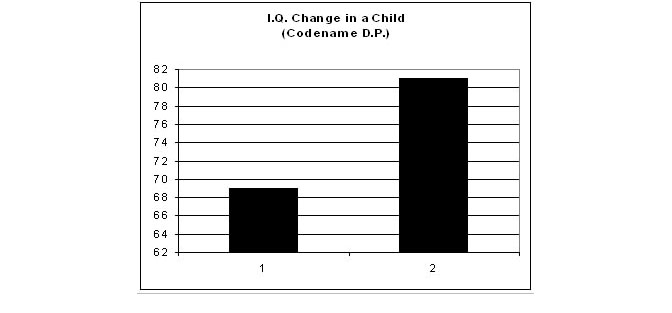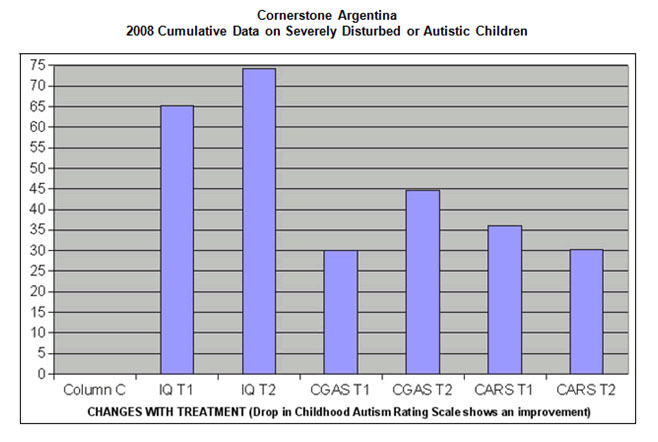Reflective Network Therapy*
has passed some important and scientific study thresholds. These include service feasibility, prospective, consecutive, controlled and comparison treatment research. Replicability readiness is another factor necessary in scientifically based therapies which Reflective Network Therapy has met, tested and proven.
Feasibility. Reflective Network Therapy can be carried out in settings as varied as day care centers, private therapeutic nurseries, mental health clinics, Head Start projects and homeless shelter classrooms and in public school special education classes.
Prospective. Reflective Network Therapy has been studied by forward-looking studies of outcomes, as well as and in contrast to backward-looking studies of archives.
Anterospective. Our data following of child patients with regard to IQ rises has included a 30-year follow-up study of a formerly autistic child patient. See: Research and Results, especially a statistical meta-analysis of Full Scale IQ changes in 79 treated versus 63 comparison and control children (“Multi-Site Study of Reflective Network Therapy Results: Twice-Tested Children”).
Consecutive. A study of outcome included a series of children with no omissions.
Controlled. A study included reasonably well matched untreated same age, race and gender children with the same diagnoses in the same school system.
Comparison treatment. Results with RNT-treated children were compared with results with children given other treatments, such as supportive-expressive group therapy, and individual psychotherapy.
Replicability. A study showing that the method can be carried out by others, who then independently also achieve the same essential results.
Two other factors we hope to gain support for are random assignment and further verification of cost benefits based on random assignments. We plan to randomly assign and have independent study of our outcomes versus other methods such as ABA, Floortime, Psychopharmacologic, and regular special education.
Replicability is another factor necessary in scientifically based therapies. Our replication manual is a vital tool for further replication. Also essential for replication are the use of training videos and observation. Ongoing laboratories for training in the technique —(Ann Martin Center near Oakland, California, Wellspring Family Services in Seattle, at the University City Children’s Center of St. Louis, MO and in Cornerstone Argentina in Buenos Aires and an innovative application of Reflective Network Therapy directed by Alexandra Harrison, MD, Assistant Clinical Professor in Psychiatry at Harvard Medical School in Cambridge, MA.— supplement archives of training and research videos from our older New York and California projects.
Psychologists will readily recognize the importance of significant gains among RNT-treated children’s IQ scores, as these measures usually change very little over time. After decades of studying Reflective Network Therapy and its feasibility in various settings, we are convinced that extraordinary IQ gains will continue to be produced and this measure will remain robust in other settings as Reflective Network Therapy is more widely used.
The easily and objectively measured increase in the standardized intelligence quotients of so many RNT-treated children is compelling in its statistical proof of one of the good effects of Reflective Network Therapy. Usually an individual’s IQ test varies by only a few points when it is repeated after a patient is treated by other methods (Siegel 1986). Thus, our results showing IQ growth resulting from treating children with Reflective Network Therapy are generally surprising. But they are even more surprising sources for therapeutic optimism about children with severe developmental disorders on the autism spectrum.
One study discussed in Reflective Network Therapy in the Preschool Classroom (Kliman, G., © 2011) deals with 10 out of 10 such children (an uninterrupted series) all of whom benefited. Our latest multi-site follow-up group of 79 children, including those ten, could simply not be predicted to grow this much in their intelligence.
Multi-Site Study Of Reflective Network Therapy Results: Twice-Tested Children
The meta-analysis [statistical assembly of an accumulation of comparable studies] of data collected over a forty year span now leads us to state that Reflective Network Therapy is an evidence-based method. Thanks are due to Michael Acree, Ph.D., of San Francisco for this meta-analytic statistical analysis. It shows the results are extremely unlikely to be due to chance. The statistical significance is better than a P= .001 level. Reflective Network Therapy has passed many scientific evaluation thresholds: manualization, replicability, feasibility in multiple settings (day care, therapeutic nursery, public special education, homeless shelters), use by many teams other than the original team, use by many therapists other than the original therapist, effectiveness in another language in another culture, blind study, controlled and comparison study. RNT been delivered very effectively to preschool children with Pervasive Developmental Disorders, as well as to other diagnostic categories of serious emotional disorders. It works in public school special education preschool classes as well as in a mental health agency.
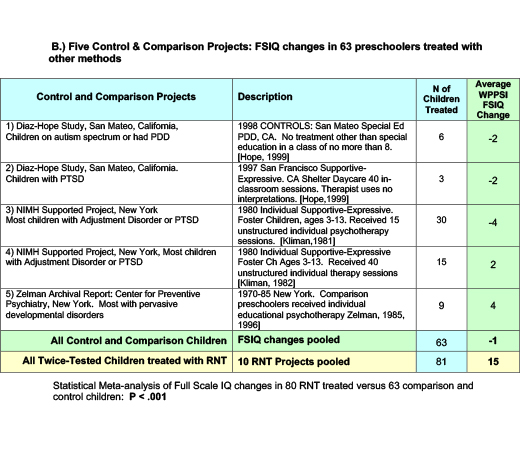 Prospective Study of Reflective Network Therapy in a Public School
Prospective Study of Reflective Network Therapy in a Public School
Objective raters (defined as professionals who were not involved in any of the children’s treatment) found an average IQ increase of one to two standard deviations.
That translates to an increase of 14 to 28 points on full-scale IQ scores. This IQ rise occurred only among children treated with Reflective Network Therapy (RNT). No IQ rise occurred at all among the children with similar disorders treated with other methods and no IQ rise occurred among the untreated control children.
All of the RNT-treated children with Pervasive Developmental Disorder whose IQs were tested twice showed show an IQ rise upon retesting. At this writing, only one of the entire population of 63 twice-tested children, no matter what the diagnosis, failed to show an IQ rise upon retesting.
IQ Rises in Children with Pervasive Developmental Disorders
The IQ rise benefits of Reflective Network Therapy are particularly significant in light of a large literature showing the stability of IQ. It is not generally found in psychological studies of intelligence that children’s IQs change much over time. A recent study of 41 preschool children with PDD including childhood autism shows that when treated with “eclectic” means such as medication, behavioral management, and speech therapy, their IQ is stable, and developmental quotient also does not rise (Jonsdottir et al 2006). This contrasts with Reflective Network Therapy outcomes and provides a robust comparison group.
Reflective Network Therapy‘s IQ gains have been sustained over decades as shown in anecdotal follow-ups. See Dorian Tenore-Bartilucci’s personal account of recovery from autism in this book for an example of this phenomenon documented by periodic testing and follow up over thirty years: Reflective Network Therapy In the Preschool Classroom, Chapter 4, Kliman, G. © 2011.
IQ Gain Correlates with Number of Reflective Network Therapy Sessions
The graph below shows the IQ gains over time from twice-tested children and points out the direct correlation between the number of Reflective Network Therapy sessions and rises in IQ, highlighting the RNT advantage in this regard.
Financial Feasibility of Reflective Network Therapy in a Public School in terms of Staff Time
The table below includes start up costs for implementing Reflective Network Therapy in public schools, including training.
Cost Effectiveness of Reflective Network Therapy as Special Education Enhancement
Reflective Network Therapy has been successfully tested in more highly varied educational and community based group settings than has the Lovaas method using one-on-one behavioral aides: public school special education classrooms, preschools, mental health clinics, private therapeutic preschools, homeless shelters, day care centers, Head Starts and has been successful in another culture. Reflective Network Therapy is successful for children on the autism spectrum as well as for children having a full range of emotional and developmental disorders, while Lovaas is primarily viewed as a therapeutic response to ASD. Mental health and cognitive gains are produced faster by the RNT method which reduces the treatment timeline and therefore the extension of all costs.
Reflective Network Therapy eliminates the necessity for one on one aides in the classroom who have been previously assigned, and accordingly lowers the associated costs. Additional reduction of expenses for staff: (a) The RNT method eliminates the costs of pull-out therapy; (b) Reflective network therapy achieves results using only 15-20 minutes per classroom day of professional psychoanalytic therapist time with each child; and, the cost of individual psychoanalytic in-classroom therapy is included in the calculated cost savings. The chart includes start up costs for implementing Reflective Network Therapy in public schools, including training.
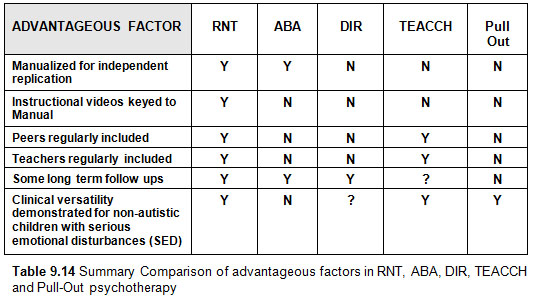
Two Year Report from Cornerstone Argentina: An Application of Psycholanalysis in Preschool Education
By Alicia Amallo Asman MD, Psychoanalyst, Infant and Adolescent Psychiatrist, Full Member of the IPA
Since April 2004 I have been managing the Cornerstone Argentina interdisciplinary program along lines designed in the United States by Gilbert Kliman, MD, using the method of Reflective Network Therapy.
This experience takes place inside a regular school building in Buenos Aires, Argentina. The Cornerstone Argentina project in Buenos Aires is a model application of psychoanalysis responding to a community need: the treatment of severely disturbed preschoolers by an analytically orchestrated network. The treatment includes a synergistic combination of in-classroom analytic psychotherapy, classroom education, and analytically informed parent guidance and family psychotherapy.
Highly disturbed or developmentally delayed preschoolers are generally not adequately treated by education or therapy alone, especially in public educational settings. This project aims to help preschoolers from 2 to 6 years old suffering from severe psychopathologies. The interventions are based on appropriate psychoanalytically informed knowledge of every child, the group and their families. Our objective is to help the children recognize themselves as individuals within a group and to integrate them into the regular education system. The children from this program join children from other classrooms and share activities such as: cooking, music, self-expression through movement, outdoor play and artistic activities.
The interdisciplinary project requires the intervention of a team that consists of: a head teacher, an assistant teacher, a psychoanalyst, a family psychotherapist and the participation of consultants such as a pediatrician, child neurologist, an educational psychologist, a social worker, a speech therapist and other related specialists. Video-documentation is a regular occurrence. I have been training more than ten Argentine therapists in the method. Argentine newspapers and magazines such as Elle are following the project, which has also received television attention.
This type of intervention consists of:
1) Psychotherapeutic, educational, and interdisciplinary intervention in a special classroom of a regular nursery school. The intervention is based on the application of the knowledge of psychoanalysis and educational psychology. Individual sessions are held four times a week.
2) Gradual child integration within the remaining classrooms, both individually and as a group with an assistant teacher.
3) Weekly parent guidance, monthly parent conferences, and family therapy.
4) Weekly supervision of the team with videotaped material of the children, and interdisciplinary network.
5) Consultation with the Medical Director Gilbert Kliman of the Children’s Psychological Health center in San Francisco, USA.
6) Making of a life history book for individual children.
7) Multi-axial Assessment Scale (CGAS) and educational-psychological follow up with WPPSI and C.A.R.S testing.
Why at school?
A human being becomes human together with another human being. The natural course is that a child grows up surrounded by other children. Providing a healthy environment and the exchange with other children turns out to be therapeutic and tend to the integration of the child with himself and with the others. Regarding this issue Freud said, “Spending a good deal of time with other children clearly forms part of a child’s normal development” in Analysis of a Phobia in a Five-year-old Boy. S. Freud. (1909).
Parents play a leading role in this project, participating in parent guidance sessions and family sessions. The whole early intervention method is tailored to the individuality of each child and his family.
Most of the children referred have received the diagnosis of Pervasive Developmental Disorders, autistic spectrum disorder, or PDD NOS. These psychiatric categories are described in the Diagnostic and Statistical Manual of Mental Disorders DSM-IV. The diagnoses are characterized by severe and pervasive impairment in several areas of development: reciprocal social interaction skills, communication skills, or the presence of stereotyped behavior, interests and activities.
Ten professionals receiving varying degrees of training in Reflective Network Therapy and two teachers were trained.
I have been delivering lectures about Reflective Network Therapy at several scientific institutions, like the Buenos Aires Psychoanalytical Association, the Argentine Pediatrician Society, the Buenos Aires University (Psychology Department), the Argentine Psychiatric Association and several public Hospitals. I also lectured at international scientific events including the International Psychoanalytic Congress in Rio de Janeiro and the Mar del Plata International Psychiatric Congress, both in 2005. I made a film showing follow ups of our patients. With the Reflective Network Therapy team we wrote papers about the development of this method in the culture of Buenos Aires, Argentina. About 450 pages of English publications on Reflective Network Therapy are also being translated into Spanish.
Clinical progress is being documented by CGAS scores and digital video tape recording. Samples of children before and after periods of treatment are available. Several reports have already been made, using such videos and written information to Gilbert Kliman, M.D.
The task has been very difficult because the children’s disorders are extremely severe. Thanks to the application of psychoanalysis and Reflective Network Therapy, we have consistently been able to obtain a positive outcome. In order to carry out this method properly we found it was very important to work closely and thoughtfully parents as well as with an interdisciplinary team. We supervise the professionals in their classroom and parent guidance work, and confer as a team every week with a deep level of theoretical and clinical discussion.
— Alicia Malao Asman, MD
Cornerstone Argentina Outcome Data
Eleven out of twelve children treated at Cornerstone Argentina using Reflective Network Therapy showed significant improvement in emotional health upon retesting.
The Childhood Autism Rating Scale is used to test children 2+ years old. Cornerstone Argentina results indicate a consistent reduction of autistic symptoms for children treated using Reflective Network Therapy.
CORNERSTONE ARGENTINA Mental Health Improvements: Further Results
RNT-Treated Patients, RNT Argentina – 2008 classroom group: preliminary data
As is the case with the following grouping, a high proportion of the children treated at Cornerstone Argentina are very severely autistic.
It is rare to see a child with a subnormal IQ climb into the normal range with any other treatment method we know of. This result is also showing up in Cornerstone Argentina where most of the children treated with Reflective Network Therapy are severely autistic. The chart below shows one child’s IQ scores climbed into the normal range from the retarded range.
Mental Health Gains in One Year
Cumulative Data: IQ Rises, Mental Health Improvements, Decreases of Autism
For more about Cornerstone Argentina as well as several U.S. service sites, see: Affiliated Service Sites
Research Regarding Effectiveness Of A Reflective Network Therapy Derivative: Psychoanalytically Informed Guided Activity Workbooks For Special Applications
A series of Guided Activity Workbooks developed by CPHC helps parents, teachers, therapists and disaster relief responders working with children and families traumatized by natural or man made disasters. These resources are derivatives of Reflective Network Therapy designed to provide psychological first aid.
Video: More Research on Reflective Network Therapy
*Earlier names used for the method (The Cornerstone Therapeutic Preschool Method or The Cornerstone Method) are interchangeable with the current name Reflective Network Therapy.

